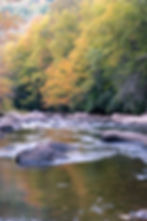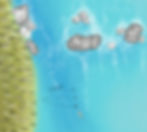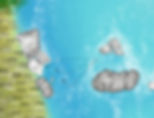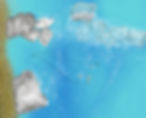How to Fly Fish Pocket Water- Casting, Mending, and Line Management
- Marc Fryt
- Feb 19, 2023
- 12 min read
This article is a part of a "How to Fly Fish Pocket Water" series and builds off of my previous articles. For the previous articles check out:
Part 1: How to Fly Fish Pocket Water: Targeting Trout Around a Single Boulder, in which we explore the unique hydraulics created by a single boulder and where trout position themselves around it.
Part 2: How to Fly Fish Pocket Water: Rock Gardens, which looks into fly fishing a boulder-strewn part of a river and where to find trout in such areas.
One of the deterrents to fly fishing in pocket water is the challenge of casting, mending, and managing your fly line in such turbulent waters. Knowing how to read water is critical for success in pocket water, and this article will help you to improve that skill. We will also go over some tips to advance your techniques at casting your flies into the right place, getting better drifts, and hopefully catching a couple more trout.
Casting Techniques in Pocket Water

When we think of casting in pocket water, the length of our casts are very short. Pocket water is a mixture of conflicting currents and trying to unnecessarily make cinematic long casts will result in your fly line being yanked and pulled all over the river. Long casts are a great way to ruin any drift you were trying to set up. Rather, get in close to where you are trying to land the fly.
What this means is that you might have to take the time to wade and work closer to your target, or if you are in a boat then focusing on pocket water that is relatively near the boat. This will help you to better mend and manage the fly line giving your fly a better drift to entice a trout to eat it.
The good thing is that trout in pocket water are not as easily spooked as they are in calmer water, the turbulent water adds a level of security for a trout. So, you can inch in closer without blowing your chances and even use the numerous boulders to hide behind to stay out of the trout's view.
Some areas of a river just might be out of reach however, and that is the nature of the beast when it comes to pocket water. Of course, you might also choose to throw a hail Mary cast across the river, but this should be after all other nearby water has been thoroughly prospected.
When fly fishing pocket water, there are a few particular casts that can be helpful based on certain situations. These casts include the tuck, reach, and pile casts and we'll cover them further into this article. First though, before we even send out any fly line we should make a quick plan of what we want to do with our cast and fly. Taking a brief second to go through this thought process will improve your skills at setting up effective casts and drifts in pocket water.
With pocket water, each potential cast needs to consider:
What is your target (i.e. where do you think the trout is)? (My previous two articles in this series really dives into locating trout in pocket water).
Where do you want the fly to land, and then where do you want it to drift?
How is the current going to affect the fly line/leader, and how are you going to mend the fly line?
Where Do You Want the Fly to Land and Then Drift?
For most of this article we will focus on using a dry fly or dry-dropper in pocket water.
When using a dry fly or dry-dropper rig you need to look for where the water is relatively calmer than the rest of the surrounding current. Too often, anglers dump their fly into foaming, churning water or amongst small standing waves which drowns the dry fly almost immediately. Look at the image below:

Let's say that we are targeting the trout at Spot A with a dry-dropper. The water upstream of the trout is pouring over some submerged boulders creating a lot of foaming, turbulent water. Landing our dry-dropper right into this foam would just sink the dry fly. If we landed the flies upstream of the foam, then yes the dry fly would float but then sink once it ran into the turbulent water.
The best option is to land the flies where the foaming, churning water starts to dissipate. This gives us a small window of calm water to float the dry fly right over the trout without the fly being submerged by the current. Using a tuck cast to land the dry-dropper into that small window, with the flies landing first before the fly line, is a great casting technique in this situation. For more information on making a tuck cast, check out this video.

Think about this the next time you are on the river fishing pocket water with a dry fly or dry-dropper. Look at the currents and pick out where there are pockets or seams of calmer water. Land your flies into water where they will have the best chance of staying afloat.
Now, when we think of where we want the fly to drift we need to keep it floating in the same seam of water in which it landed. If we suspect a trout is feeding in a particular seam of water then we should land our fly in that seam upstream of the trout, and then keep it drifting in that lane. Trying to pull or drag a dry fly across seams is another good way to have it sink. If you land your flies into the wrong seam then just let that drift play out. At the end of the drift, pick up and cast again.
Next, to help us maintain our drift we have to anticipate how the river's current is going to push or drag our fly line/leader. Thinking about this will get us ready to mend the fly line in order to keep our flies drifting in the seam that we want.
How is the current going to affect the fly line/leader, and how are you going to mend the fly line?
Mending flies in pocket water feels like a constant chore, because it is. However, we have to mend the line/leader in order to keep our flies floating and in the seam of water that we want. If you ever wanted to improve your skills at mending line, pocket water is the place for you to practice.
There are two primary methods to mending, making an upstream or downstream mend. Either mend requires you to read the water and anticipate which one to do. Let's look at upstream mends first.
Upstream Mends
Looking at the image below, we can see a trout downstream of a group of boulders. There is some heavy, fast current (the black arrow) and on either side are slower currents (the gray arrows indicate the seam between the fast and slow currents). A trout is holding to the right of the faster current. Let's say we are standing on the left bank, and our aim is to land the fly upstream of the trout and into the slower seam that the fish is holding in (the gray arrow on the right).

Now, let's assume we just cast our fly into the river without mending at all. Looking at the images below (click to enlarge them), we can see that although the fly lands right where we want (that seam between the fast and slow currents), the faster current grabs hold of the fly line/leader and pulls it down stream. This forces the rest of the fly line/leader to follow which drags the fly out of its lane thus missing the trout:
In this same situation, if we mend the fly line/leader it would help us to drift the fly right to the trout. Making an upstream mend of the fly line in this case means:
Looking at and anticipating where the faster current is going to pull on the line/leader.
Making our cast and flicking the line upstream (at the spot where the faster current intercepts the line). This will mend will help minimize the faster current's affect on the line.
Repeating this mend as many times as necessary to keep the fly drifting where we want.
Check out the image below which shows this upstream mend:

Instead of the fly being dragged across the water and missing the trout, we are right on target with little to no drag being induced on the fly. Also, notice in the image above that the mend was at the spot where the faster current intercepts the line/leader. Placing the mend as close to the spot that we need it makes it more effective in controlling our drift. Be as accurate as you can with your mends, it takes practice.
There may have been times when you were on the water, made a cast, mended the line perfectly, and the fly still didn't drift the way you wanted. At times like this, it may come down to paying particular attention to where your fly exactly landed. In pocket water, there are subtle differences in water speed and directions, being able to pick up on these details will help to give you better drifts.
To explain this, the image below shows a trout tucked up in a pocket of calm water immediately downstream of a large boulder. The trout is sitting in bucket of water that is practically motionless because the boulder upstream is deflecting the river's current. This trout can easily dart over to the right in order to nab food as it passes by:

On our first cast, we land the fly right into the bucket just upstream of the trout, then we make an upstream mend to limit the faster current's affect on the line/leader. However, since our fly lands in that very calm water it just stalls out and sits there. Meanwhile, the mend that we made in the fly line straightens out and then the line is swept downstream with the faster current. Our fly is dragged away due to the tension in the fly line, and we miss the trout:

What we need to do on our second cast is pay particular attention to where we land the fly. We do not want it to get stalled out again in that calm bucket of water. Rather, we need it to land right on the seam between the fast current and the pocket of motionless water. This will allow the fly to float in a gentle current (the seam) and right in the trout's feeding lane. Again, we have to mend the fly line upstream in order to keep the fly drifting where we want:

The difference between the two casts is subtle, but the second cast landed the fly into moving water (the seam) instead of slack water. Placing the fly just a few inches to the right made all the difference and we were able to present the fly right to the trout on a good drift.
Many times in pocket water, achieving good drifts comes down to these subtle fly placements. Just like in the example above, we have to land the fly not in slack nor fast turbulent water but in the narrow seam of current between the two. Watch for these details the next time you are on the river.
Casting Across Multiple Currents
Remember, success in pocket water means trying to limit the length of your cast because we do not want to try to mend across multiple currents. Casting across multiple currents, no matter how accurate the cast, will expose the fly line/leader to numerous and conflicting speeds of water that will all push, pull, and drag the line/leader.
Below, we have a situation where we are near the left bank of the river and make a cast to the middle of the river. We cast, land the fly line/leader across multiple currents, and quickly make an upstream mend nearest to us (in this image, the faster currents are shown as darker blue areas):

Although our mend nearest to us was able to cancel out the effect of that fast current, the other faster current near the fly grabbed hold of the leader and pulled it downstream. Our fly immediately drags through (and probably goes under) the water, completely missing or spooking the trout.
Now, you may be thinking, "why not just throw in a huge mend that reaches across the two fast currents?" Well, in between the two faster currents is a slow pocket of water (the lighter blue water). Any excess line that gathers up in this slower water will just stall out and do us little good until the faster currents inevitably grab hold of the line. Also, a large mend will require quite a bit of line, and this slack will make it very difficult to both manage the fly line and set the hook on any trout that goes for the fly.
Downstream Mends
Mending the fly line and leader will not always require an upstream mend, instead there are situations where a downstream mend will be more effective. Most often, if a trout is sitting in faster current, and there is slow current between you and the fish, then you will make a downstream mend. In this case, a downstream mend will allow the line/leader to keep pace with the fly since it is traveling in faster water.
The image below shows this scenario where a trout is sitting downstream of a group of submerged boulders. The trout is centered in a channel of quicker water. We are standing on the right bank, and there is slower current between us and the trout. The channel of water where the trout is stationed is not too turbulent so our fly should have little issue staying afloat once we land it there...if we properly mend the line:

We make our cast, immediately mend downstream, and the fly line/leader are able to keep pace with the fly all the way to the trout:

If we did not mend the line downstream then it would have acted link an anchor pulling the line taught and dragging the fly out of its lane before ever getting near the trout.
Reach Cast
With either an upstream or downstream mend, you can actually place the mend in the fly line before it ever touches the water. This is accomplished via a reach cast (also known as an aerial mend). This cast is a great way to quickly get set up for a drift and to have the fly landing with a mend already established.
Knowing and practicing the reach cast will prepare you for some of those black diamond spots in pocket water. Check out this video which gives a demonstration of the reach cast.
Pile Cast
While not a mend, another cast to have in your skillset while fishing pocket water is a pile cast. If you are casting to a trout directly downstream of you, a pile cast is a decent way to build slack into the line. The reason we need slack in the line is because the fly is going to drift downstream of us and we need to pay out additional line so we don't immediately come tight to the fly after it lands. For a demonstration of the pile cast watch this video.
We can either pay out slack as the fly floats downstream or use a pile cast (or a combination of the two). A pile cast is just an easy way to put slack into the system before the fly ever touches water. Once the fly lands, there is enough slack ready to go which aids our drift:
Line Management in Pocket Water
While mending is a part of line management, there are a few other considerations to help you better handle the fly line. Being mindful of these line management tips and and techniques can improve your drifts and hook sets while fishing pocket water.
Only have as much line as you need. Whether in a boat or wading in the river, anglers sometimes peel off too much line from the reel than what they actually need. This excess of line becomes a mechanism to be caught in the current, wrapped around legs, or snagged in the boat which hinders effective casting and mending. Strip off only as much line as you need and reel in the rest.
Build slack into your casts. When casting downstream, quartering downstream, or across stream place some slack into your casts. Allowing the fly line to land on to the water with a little slack will set it up to be mended immediately. Again, the reach and pile casts are also ways accomplish this.
Setting the hook. With all of this slack and mending, it is easy to miss hook sets on trout. To avoid some of this frustration, your none casting hand should always be ready to take in slack in order to remain "in touch" with the fly. Oftentimes, a hook set in pocket water is a combination of both stripping in the line (a strip set) and a trout set (raising the rod tip high).
Short leaders. A shorter leader (around 7.5ft) means less leader material that you will have to mend. We can get away with shorter leaders because the trout in pocket water are not as easily spooked as in calmer water. A shorter leader can also help us to high stick more easily.
High sticking. This is a method that greatly reduces how much you have to mend. High sticking is holding the rod high, out and away from your body so that very little of the leader and fly line actually touch the water (check out the image below). In some cases, if you are able to wade close to a trout you can hold the rod out and away from your body so that only the fly is touching the water and none of the line/leader. When high sticking, your drifts will be much shorter but they will be as close to drag-free as we can get.

Casting, mending, and managing fly line in pocket water can be tricky, but taking your time to read the water and setting up a plan will help you to anticipate how the river's current is going to affect the line, leader, and fly. The technical aspect of pocket water is what makes it enjoyable, and it will advance your casting and mending skills as an angler.
Reading Pocket Water Part 1 here: How to Fly Fish Pocket Water: Targeting Trout Around A Single Boulder
Reading Pocket Water Part 2: How to Fly Fish Pocket Water: Rock Gardens
Reading Riffles: Improve Your Skill at Reading Water for Fly Fishing: Riffles
Lastly, if you live in or are visiting Spokane, I provide guided fly fishing trips and instructional lessons around Spokane to include float trips on the Spokane River and stillwater trips across various Eastern Washington lakes. I guide with Fly Fish Spokane, and more information/trip rates can be found at the website: FlyFishSpokane.com













